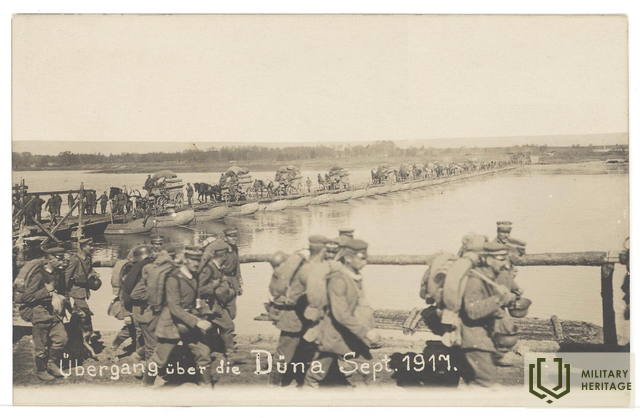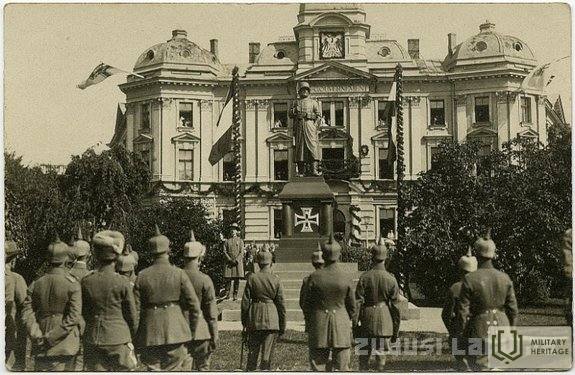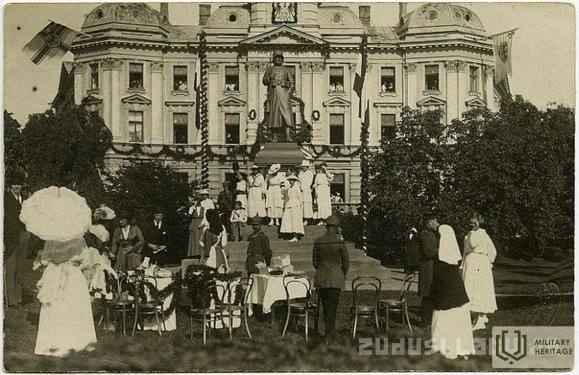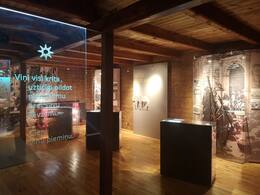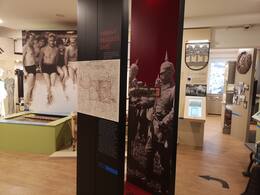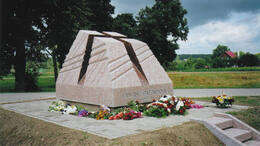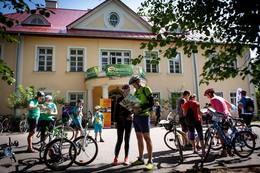Jugla lahing – Itje pealetung I I maailmasõda
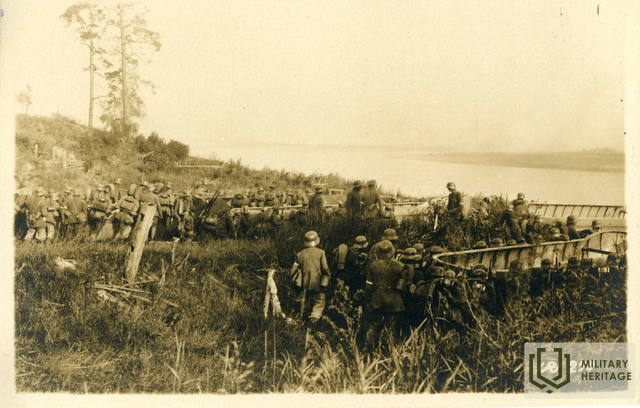
Riia operatsioon, sõjaajaloos tuntud ka kui Riia lahing või Hutieri Riia pealetung (saksa keeles Schlacht um Riga — 'Riia lahing', inglise keeles Hutieri pealetung Riias), oli Saksa keisririigi 8. armee pealetungioperatsioon Esimese maailmasõja ajal eesmärgiga vallutada Riia ja piirata sisse seda kaitsvad Vene Vabariigi 12. armee osad. Pärast 1917. aasta veebruarirevolutsiooni ja monarhia kaotamist vähenes Vene armee lahinguvõime iga kuuga. Juba suve lõpuks võib neid vägesid sõjaväeterminoloogia kohaselt julgelt nimetada "rahvamiilitsaks". Lahingud toimusid 1.–6. septembrini 1917. Saksa poolel osales rünnakus üle 60 000 sõduri, Vene poolt kaitses 161 000 sõdurit. Mazā Jugla lähedal toimunud kaitselahingus suutsid 2. Läti laskurbrigaadi sõdurid takistada Vene vägede sisenemist piiramisrõngasse.
Saksa 8. armee ülemjuhataja Oskar von Hutier soovis Riia lähedal katsetada uut sõjapidamismeetodit, kus mitu tundi kestnud ülikoondatud ja kombineeritud suurtükitulele 500 x 400 m ristkülikutes järgnes kohe jalaväerünnak. 1. septembri 1917. aasta hommikul, pärast kolmetunnist suurtükituld, alustasid sakslased Daugava ületamiseks puidust pontoonsildade ehitamist. 1159 suurtükist ja miinipildujast tulistati umbes 560 000 mürsku, mis surusid täielikult maha 66 Vene suurtükki ja sundisid Daugava paremal kaldal paiknenud 186. diviisi taanduma.
Pärast suurtükituld algas 2. septembril keset päeva rünnak Läti laskurite positsioonidele. Kaitselahingud puhkesid 14 km pikkusel rindel Mazā Jugla jõe paremal kaldal. Enne Mazā Jugla jõe lahingut ei olnud 2. Läti laskurite brigaad varem ühiseid lahinguoperatsioone läbi viinud, mõnikord tegutsesid kaks rügementi koos ühes operatiivgrupis. 1917. aasta suvel sai brigaad täiendust või marsse Läti laskurite reservrügemendilt, mis paiknes Valmiera rajoonis. Enne Mazā Jugla lahingut oli 2. brigaad kolm kuud, 15.05.1917 kuni 21.08.1917, positsioonidel Ložmetējkalnsi ja Kalnciemase maantee piirkonnas. Sel perioodil lahinguid ei toimunud, kuid pikk kaevikutes viibimine, toit ja muud probleemid kurnasid sõdureid.
Mõne suurtükiga 2. Läti laskurbrigaadi sõdurid seisid silmitsi arvuliselt ja tehniliselt tugevama Saksa vägede rühmaga, kes rünnakus kasutasid ka lennundust, leegiheitjaid ja mürgimürske. Laskurväelastel õnnestus kangelaslikult rinnet hoida 26 tundi kuni 3. septembrini, mil Vene 12. armee peajõud olid Riiast juba Riia-Petrogradi raudteed mööda välja tõmmatud. Olles oma ülesande täitnud, taandusid ellujäänud Läti sõdurid 12. armee juhtkonna käsul Sigulda ja Cēsise positsioonidele. Kaotused olid väga suured - üle poole 5. Zemgale ja 6. Tukumsi Läti laskurrügemendi võitlejatest löödi rivist välja, 7. Bauska ja 8. Valmiera Läti laskurrügement kannatasid vähem.
Rohkem teabeallikaid
https://lv.wikipedia.org/wiki/R%C4%ABgas_oper%C4%81cija#cite_note-autogenerated1-1
http://latviesustrelniekusaraksts.lv/Kaujas_darbiba/Book_3.html
Seotud objektid
Jõeorgu kraav
Marsruudi alguspunkt asub Upesleji kesklinnas bussipeatuse lähedal.
1. septembri 1917. aasta hommikul, pärast kolmetunnist suurtükitulekahju, alustasid sakslased Ikšķile lähedal kolme puidust pontoonsilla ehitamist üle Daugava jõe. 1159 suurtükist ja miinipildujast tulistati umbes 560 000 mürsku, mis surusid täielikult maha 66 Vene suurtükki ja sundisid Daugava paremal kaldal paiknevat 186. diviisi taanduma. Vene 12. armee ülem kindral Parskis käskis 43. korpusel alustada sissetungi korral vasturünnakut ning andis korpuseülema käsutusse 33., 136. ja 138. diviisi, ühe 116. diviisi brigaadi ja 2. Läti laskurbrigaadi.
1. septembri pärastlõunal said Läti laskurid käsu liikuda edasi võitlusse Daugavat ületavate sakslaste vastu. Ropažist asunud 2. Läti laskurbrigaad läks ründavatele Saksa üksustele vastu ja 5. Zemgale Läti laskurrügemendi sõdurid jõudsid Mazā Jugla jõe paremal kaldal asuvatele kindlustatud positsioonidele umbes kell neli pärastlõunal. Pärast suurtükituld algas rünnak Läti laskurite positsioonidele 2. septembril keset päeva. Kaitselahingud puhkesid 14 km pikkusel rindel Mazā Jugla paremal kaldal. Mõne suurtükiga 2. Läti laskurbrigaadi sõdurid astusid vastamisi arvuliselt ja tehniliselt tugevama Saksa vägede rühmaga, kes kasutasid rünnakus ka lennundust, leegiheitjaid ja mürgiga täidetud kahurimürske. Laskjatel õnnestus rinnet kangelaslikult hoida 26 tundi kuni 3. septembrini. Pärast oma ülesande täitmist taandusid ellujäänud Läti sõdurid 12. armee juhtkonna käsul Sigulda ja Cēsise positsioonidele. Kaotused olid väga suured – üle poole 5. Zemgale ja 6. Tukumsi Läti laskurrügemendi võitlejatest said lüüa, samas kui 7. Bauska ja 8. Valmiera Läti laskurrügement kannatasid vähem.
Tīnūži Mõisa Kultuuripärandikeskus
Tīnūži Mõisa Kultuuripärandikeskus asub Tīnūži külas Ogre piirkonnas, 7 km kaugusel Ogre ja Ikšķile linnadest. Esimesed kirjalikud tõendid mõisa kohta pärinevad 16. sajandist. 18. sajandi keskpaigani oli mõis väikeste ja tähtsusetute hoonetega majapidamine, kuid aja jooksul kasvas see suureks kompleksiks. Esimese maailmasõja ajal toimusid siin Vene ja Saksa armeede vahel lahingud, milles osalesid ka Läti kütipolgu sõdurid. Vabadussõja ajal asus Tīnūži mõisas Läti sõjaväe 1. Valmiera jalaväepolgu staap ja seal hoiti soomusautosid. 1932. aastal anti mõis Läti Sõjainvaliidide Liidule, mis pakkus majutust sõjaveteranidele ning hoolitses nende eest. Teise maailmasõja ajal 1943. aastal viidi Eestist Tīnūži mõisa üle SS-Jagdverband Ost. See oli üksus, mis valmistas ette sõdureid võitluseks Punaarmee vastu. Luuramist, partisanisõja taktikat ja sabotaaži õpetati ka läti sõduritele. Tīnūži mõisa härrastemaja hävitati, kui Punaarmee liikus Riia suunas. Tänapäeval on näha kaunist maastikku ajalooliste hoonetega Väikese Jugla (Mazā Jugla) jõe kaldal. Tīnūži Mõisa Kultuuripärandikeskuses saab näha ajaloolistele sündmustele, sh Läti küttidele, pühendatud eksponaate.
Ogre ajaloo- ja kunstimuuseum
Ogre ajaloo- ja kunstimuuseum asutati 1981. aastal. Muuseumi kollektsioon hõlmab enam kui 40 tuhat erinevat eksponaati, mis on kogutud Ogre linna ja endise Ogre rajooni territooriumilt. See kajastab ulatuslikult kultuuri- ja ajaloopärandit antiikajast tänapäevani.
Näitusel „Pangast muuseumiks“ saavad külastajad tutvuda Vabaduse tänaval 36 asuva hoone ajaloo ja selle muutumisega 50 aasta jooksul. Algselt NSV Liidu pangana ehitatud hoonest on hiljuti saanud Ogre ajaloo- ja kunstimuuseumi kodu.
Näitus „Puhkajad Ogres“ on pühendatud linna ajaloo ühele eredamale ja legendaarseimale leheküljele. See näitab puhkevõimalusi, puhkajate meelelahutust ning Ogre kultuuri- ja seltsieluga seotud legende 20. sajandi algusest kuni Teise maailmasõjani. Ogre kui kuurortlinna elulugu esitletakse hoolikalt valitud dokumentide ja esemete ning nende atraktiivse kunstilise esitluse abil.
Muuseumi näitused vahetuvad iga kuu. Temaatilised näitused on tavaliselt pühendatud erinevatele ajaloolistele sündmustele, kuid kunstinäitustel on esindatud nii Ogre omavalitsuse kui ka kogu riigi kunstnikud, näiteks maalikunstnikud, keraamikud, graafilised disainerid, fotograafid ja teiste loominguliste elukutsete esindajad.
Mazā Jugla lahingu monument Tīnūžis
Asub Ikšķile vallas Tīnūži külas maantee ääres Tīnūži algkooli lähedal.
Mälestusmärk Läti laskuritele, kes võitlesid Esimese maailmasõja ajal Saksa armee vastu. Mazā Jugla jõe lahing 1.-2. septembril 1917 oli Riia operatsiooni kulminatsioon. Saksa armee alustas Ikšķile vastu rünnakut eesmärgiga vallutada Riia ja vangistada Vene 12. armee. Saksa armee üksused, mis ületasid Daugava pontonsildade abil, jõudsid Mazā Jugla jõe ümbrusesse, kus Läti laskurid nad blokeerisid. Neile anti käsk vaenlast kinni pidada, kuni kogu Vene 12. armee pääseb piiramisest ilma Saksa armee poolt vangi langemata. Lahingud toimusid mõlema sõdiva poole raskete kaotustega.
Tänapäeval saab külastada skulptor Jānis Karlovsi loodud Läti võitlejatele pühendatud monumenti "Kangelaste altar", mis avati 2005. aastal. 300 meetri kaugusel asub Tīnūži mõis, kus asub näitus.
Mercendarbe mõis
Asub Baldone vallas, 4 km kaugusel Baldonest, Iecava – Baldone – Daugmale maantee lähedal.
Mercendarbe on üks mõisatest, mille lähedal asus Läti vanim Baldone spaa. Mõisa ajalugu täiendavad Esimese maailmasõja sündmused. See asus 7 km kaugusel aktiivse rinde lahingupaigast - Nāves salast. Mercendarbe mõis teenis Saksa armee eesmärke ja selle ümbrus sai sõja otseseks tunnistajaks.
Sõja ajal oli raudteetaristu iga armee plaanides üks olulisemaid küsimusi. 1915. aastaks oli Saksamaa okupeerinud Läti territooriumi (sel ajal Venemaa osa) ja alustas uute raudteeliinide ehitamist, et kiiresti transportida sõdureid, korraldada varustust ja eksportida ressursse Saksamaale, näiteks puidulasti. Üks uutest raudteeliinidest ühendas Mercendarbi Vecumniekiga ja edasi Jelgavaga, mis oli Saksa armee jaoks oluline tugipunkt. Mercendarbi liini kasutati Surmasaare sõdurite varustamiseks ning see pakkus tuge ka Saksa armeeüksustele, kui need ründasid Riiat, ületades Daugavat.
Tänapäeval asub mõisas Baldone muuseum ja turismiinfopunkt. Loodud on palgasõdurite matkarada, mis on osa „Baldone lugude rajast“. Ikka veel on näha Saksa armee raudteetammi.
Saksa sõjaväeraudtee lõik Mercendarbe-Skarbe marsruudil
Endine raudteetrass on looduses selgelt nähtav, kuna raudteetamm on säilinud praktiliselt kogu teelõigul, kus tänapäeval on mets. Mööda tammi kõndides pöörake tähelepanu pinnakattele – on võimalik näha säilinud liiprite kohti. Tänapäeval on mõned raudteelõigud teede alused, näiteks metsaraie rajamiseks. Mercendarbe mõisa lähedal on raudteetamm tasandatud, kuid Riekstukalnsi lähedal, kus mets taastub, see jätkub.
Baldone ajaloo uurija O. Anderson kirjutab selle raudtee ajaloost järgmiselt:
„Esimese maailmasõja ajal, kui 1916. aastal oli rindel Daugava jõe vasakul kaldal stabiliseerunud Saksa armee varustamiseks, otsustas armee raudteeteenistuse ülem 15. märtsil 1916 ehitada liini Vecumniekist Mencendarbisse. Liini pikkus oli 25 kilomeetrit. 30. märtsil alustas tööd 5000 töölist ja 1. maiks oli liin ehitatud Skarbe jaama ja 6. maiks Mercendarbini. Raudtee algas Vecumniekis Neugut Kurlandi jaamana, seejärel Nougut Nord, Birsemniek, Gedeng, Skarbe, Merzendorfi jaamadena (saksa nimed). Hiljem pikendati liini Riekstu Kalnani ja Ikšķile vastas asuva Vilki Kalnani. Kuna Jelgava-Krustpilsi liin oli juba ümber ehitatud Saksa (Lääne-Euroopa) rööpmelaiusele, siis liiniks laiusega 1435 mm. See polnud enam mingisugune „väike sild“, vaid tavaline…“ raudtee. Suurim jaam oli Skarbe. Seal toimusid ka suurimad kaubakäitlustööd, et neid saaks hobuste veoga rindele transportida. Raudteeliin oli veel töös 1921. aastal, kui seda mööda saadeti palke ja küttepuid. See lammutati 1925. aastal. Tänapäeval on jaama asukoht säilinud puutumata, näha on raudteed, rööbaste muldkeha ja liiprite kohti. On hämmastav, et pärast 100 aastat saame mööda seda raudteed kõndida. Tundub lihtsalt, nagu rong tuleks kohe ja me peaksime kõrvale astuma.“
Seotud lood
Väikese Jugla jõe lahing / Riia operatsioon
Jutustaja kirjeldab oma muljeid Riia operatsiooni algusest, kui Saksa armee suurtükivägi alustab Vene armee positsioonide pommitamist. Ta kirjeldab Vene armees valitsevat kaost ja Läti laskurite meeleolu enne lahinguid.





